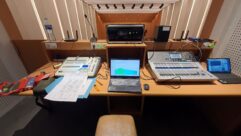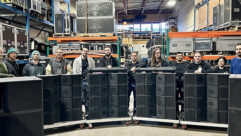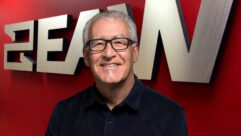Sailing on a Sea of Sound
Sep 1, 2002 12:00 PM,
BY CHRISTOPHER BUTTNER
Known for its fleet of luxurious ships, Princess Cruise Lines has long ferried relaxed passengers from the coldly beautiful coast of Alaska to the warm, sunny beaches of Mexico. As part of its effort to revamp the sound systems of its ships, Princess Cruise Lines turned to Thomas Gregor Associates (TGA), a full-service systems-integration firm.
Founded in 1984, TGA entered the cruise ship industry through a recommendation from a Princess Cruise Lines producer who was familiar with TGA’s Las Vegas casino showroom work. The producer wanted a high level of technical requirements from the performance that the low-tech systems aboard the ships could not provide.
TGA cofounder Greg Kirkland said the balance of the firm’s workload is in multiuse and other performing-arts facilities. A large segment of the company’s business accounts for systems integration for theme parks; the company also has diversified quite a bit in the past few years. Other clients include Boeing Corp. manufacturing facilities and boardroom systems for the Los Angeles Unified School District.
“The low-tech systems of that era could not meet the performance’s demands,” Kirkland says. “At first we were called in as consultants, and then we gravitated into doing all the installation work, as well. Over the years, we’ve somewhat reluctantly become known as the cruise ship entertainment systems company, and approximately 40 percent of our overall business is with the cruise industry.”
TGA refitted most of the older Princess ships in the fleet since the early 1990s and designed systems for the first in the series of the largest cruise ships ever built, including the Grand Princess, which was launched in mid — 1998. The company also designed and installed the entertainment systems aboard the two newest Princess ships, the Golden and the Star.
The Golden and Star are probably the most elaborate floating entertainment facilities ever set to sea. The Golden Princess launched in early 2001, and the near-duplicate Star Princess launched in March 2002. Both feature almost identical Peavey MediaMatrix systems, consisting of a combined 13 mini- and mainframes that handle shipwide audio routing for each vessel’s 26 entertainment venues and all common areas. At 951 feet in length and 109,000 tons, the vessels represent two of the largest, most exquisite cruise ships afloat, and each sports a price tag of $450 million.
The completely networked MediaMatrix system delivers more than 16 channels of high-quality audio to every venue and deck onboard the ship. “The MediaMatrix systems are by far the most elaborate, 100 percent fiber-optic audio-routing systems of their kind on any ship afloat,” Kirkland says. “No copper is used in the audio-routing system aboard the vessels.”
Additionally, TGA designed and installed the performance audio, lighting, and video systems for all 26 entertainment venues, including the ship’s three theaters, using Apogee Sound loudspeakers powered by Apogee Sound DA-800 digital power amps.
Design work began on the Golden Princess in mid — 1999, almost immediately after the launch of the Grand Princess. “The Grand Princess was the last of the copper-wired, analog-networked systems for Princess,” Kirkland says. “It was after careful examination of the Grand Princess project that my partner, Christian Hugener, realized that a networked MediaMatrix system would fill the audio distribution needs of a modern cruise ship. A Peak Audio CobraNet-backbone, networked MediaMatrix system would provide much more flexibility, not only in programming but also in control, than any other system available.”
The 26 entertainment venues consist of everything from the main theater to movie theaters to discos, lounges, and an Italian restaurant and pizzeria. The Grand Princess featured local audio sources at every venue, anything from CD players to cassette decks. The cruise director distributed specific music to those areas on CD or cassette, but after a period of time, the staff working in that area would get tired of listening to the same music all the time. The venue staff would then begin playing other music — such as Metallica — that didn’t fit the cruise director’s background-music criteria.
“Invariably, the passengers were soon exposed to the musical tastes of the venue staff, which did not always fit in with the entertainment requirements,” Kirkland says. “That was a priority issue. It would drive the cruise director’s staff nuts, and they would cringe when they would tell us these stories. There was an audio source available from the broadcast center, but it was nothing more than two background-music channels that no one paid much attention to.”
ROCK TO BIG BAND
TGA’s plan called for a networked MediaMatrix system consisting of 16 sources of digital music from 9 GB AEI servers installed at the broadcast center. AEI created 16 channels of custom program material specifically for Princess featuring every kind of music, including big band, pop standards, themed island music, and rock ‘n’ roll. The shipwide customized music is simply and frequently updated through downloads onto the AEI hard drives so that the content doesn’t get stale.
TGA worked closely with Princess and the shipyard to provide an unparalleled music delivery system. The result was a shipwide MediaMatrix backbone utilizing the CobraNet protocol capable of routing and processing control features. “In the early stages, we mapped out a matrix of the ship’s 26 venues, along with the entire general passenger spaces, such as hallways and atrium lobbies,” Kirkland says. “Not only did we map out and determine all of the audio control features but we also got specific to the point that Princess even decided on the type of music it wanted to route to every area.”
The front end of the MediaMatrix system consists of a 960 mainframe with redundant backup located in the ship’s broadcast center, and each of the three theaters has its own mainframe. The smaller miniframes are distributed throughout the ship and share digital signal processing depending upon the requirements of the venue. One miniframe can handle routing for as many as three smaller venues. TGA used Hewlett-Packard converters to come off the fiber and then switch to different locals through Cat-5 cable.
All of the mini- and mainframes are networked together, and all are remote-accessed through a Microsoft Windows 2000 operating system. Depending upon the level of password, a user can operate any venue from any mainframe anywhere in the ship or from the broadcast center. The broadcast center is the main interface where all audio can be controlled shipwide. The chief communications officer and select staff are the only crew members who have entire shipwide control of the audio systems.
To limit the chance of hearing the same song more than once during the weeklong cruise, source material for each area of the ship consists of four channels of different musical styles and genres.
TGA installed AMX touch pads in the smaller venues — the larger venues used AMX touch screens — and the music varied by the venue type. For instance, the Italian restaurant and pizzeria has several selectable Italian music channels, including the opera channel.
Princess also wanted background music in the passenger cabin hallways, but the cruise line wanted the music to play from 10 a.m. until about 7 p.m.
“The MediaMatrix allowed us to do something that we could never do before, which was set up an automatic schedule to bring in or bring out the background music in the hallways and other common areas adjacent or in close proximity to the passenger cabins,” Kirkland says. “On previous ships, passengers hated the music in the cabin hallways because it was on all of the time, and it would leak into the cabins.”
It’s not just a background-music system, Kirkland says.
“Much of the music is foreground music for areas such as the theaters, the cabaret, and especially the disco,” he says. “The disco even has its own mainframe, as do the main, cabaret, and aft theaters.”
The disco’s mainframe handles all of the inputs coming into the DJ booth and distributing throughout the large two-dance-floor venue.
When the operator leaves the disco, he hits a preset on the AMX panel, and the system is taken back to the background-music channel that has been deemed appropriate — for that point in time — for the venue. The disco is more than 1,000 feet from the broadcast center and the AEI servers, which is as far as you can get aboard the ships. The broadcast center is located in the forward lower decks, and the disco is located on the 18th deck aft. The disco gets the background music over the fiber-optic network as effectively as every other area aboard the ship.
SHIPSHAPE
The forward main theater utilizes the CobraNet protocol to a great extent. TGA installed a 16-by-16 Level Control Systems (LCS) matrix in the main theater. “It’s all running CobraNet, as the program material never hits analog,” Kirkland says. The breakout boxes or CobraNet audio bridges in the theater take the incoming signals from the Crest Audio Century console, out of MediaMatrix, via CobraNet through the LCS, and then back into the MediaMatrix for distribution to the theater sound system.
“They really mix some pretty impressive shows fully utilizing the LCS for some impressive surround sound effects,” Kirkland says. “Princess Cruise uses the Tascam DA-88s fleetwide for tracks that augment the live band. The DA-88 also triggers the LCS through time code.”
Two of the theaters also have the ability to show movies in surround sound, and the main theater can quickly be configured for a movie presentation, as well. TGA uses some 5.1 blocks for the MediaMatrix view file that the soundboard operator can quickly access from the view file graphical user interface.
FIBER VERSUS COPPER
TGA quickly discovered that shipbuilders love fiber optics. “In the event of a fire, copper acts like a heating coil and transmits intense heat, like a fuse, between fire zones, regardless of how well insulated it is,” Kirkland says. “But when you go to fiber optic, should it catch on fire, it just melts away and does not transmit fire to the next fire zone.”
Marine wiring is an exacting science. If you make a mistake by not connecting or running an important cable, then you have some time and monetary problems with pulling down major parts of ceilings, walls, floors, and so on to correct the problem. All cabling is measured perfectly — a 90-degree angle has to be a 90-degree angle. “Regardless of the type of cable, there is always a lot of cable to pull in a new build project like this,” Kirkland says.
In previous new construction projects, TGA had to impart marine wiring practices to isolate AC lines from copper low level and speaker lines to avoid RF noise, ground loops, and other anomalies. However, the fiber-optic cable could be strapped to a high-power main. “We’re never going to have any RF or other noise problems in the audio system — ever,” Kirkland says.
ATTENTION, PASSENGERS
Whenever a page is made on an older ship, passengers will often hear a clunk over the sound system. The music stops, everyone hears someone fumbling with the microphone, and then the page begins. That problem happened no matter who was doing the page — the purser, the cruise director, or even the captain. “We were tired of the 1930s technology of old relays, and (the system) sounded like it,” Kirkland says. “As audio professionals, the entire ship is a professional performance venue, and a ship thrives on pages. Therefore, let’s do them professionally.”
TGA set up an entertainment paging system, using Peavey’s PageMatrix, in which the page-related processing is routed through the MediaMatrix software. Instead of a noisy and abrupt audible break-in during pages, there is a gradual ramp down of the music before the bing-bong tone alerts the passengers that a page is coming in. When the page is completed, the music ramps back up again. There are several paging stations throughout the ship, but the bulk of the pages come from the purser and cruise director’s desk, as well as the bridge.
“Princess management was impressed when we demonstrated this entertainment paging concept,” Kirkland says. “They were not aware that this type of system was available.”
It took jumping through a lot of hoops to get the paging system approved, especially through the Safety of Life at Sea code, as well as the highest levels of Princess and the shipyard. At first the shipyard was adamant that paging could be done only through a system of copper and relays. “We pointed out that what we were proposing was a standalone entertainment paging system as part of the background-music system,” Kirkland says. “Finally, we were cleared on the entertainment paging system, because Princess realized the value of providing a professional-sounding page. Also, our system would not affect the life safety system, and life safety would remain as a different system, with its battery backups and other fail-safes.” TGA feeds the entertainment pages through the entertainment sound systems as found in the theaters and other performance venues, greatly improving on overall audio quality and, therefore, professional presentation.
In any area where crew members need to make emergency pages, there are two microphones, the PageMatrix and the Philips emergency system — paging mic. For the local paging zones in which no amplification is needed, TGA feeds the entertainment and paging background music into the second input of one of the two inputs on the Philips amplifiers used in the life safety system. When the captain has to make a life safety page or when an emergency page is made from the engine control room, every MediaMatrix function gets overridden through hard relays. “Just the fact that the Philips paging amps had two inputs and controllable switching made simple work of the integration of the MediaMatrix network into the rest of the ship, alongside of the 26 entertainment venues,” Kirkland says.
AVAST!
TGA knew that once MediaMatrix was up and programmed, it would be a solid system and you wouldn’t know it was there. “After a ship is basically built and it’s still in the dock — and we’re in the commissioning, test, and adjust phase — its power can be shut down either shipwide or by fire zones,” Kirkland says. “I can remember being in the middle of programming aboard a ship — which is why we did the majority of the programming off-site — and we lost power in the main theater, and everything that I was programming was lost.”
That was the least of TGA’s problems. When the power dies and then comes back, a concern about damaging the hardware remains. The MediaMatrix mainframes have power supplies that are expensive and robust, and there is a good reason for that. When the power kicks back on, the system isn’t toast. “When the MediaMatrix powered back up, Windows 2000 came back up every time without fail,” Kirkland says.
MediaMatrix allowed TGA to program from anywhere aboard the ship or in the office. “Most of the time, you’d find three of us at a table with our laptops just banging out the settings,” Kirkland says. “We had actually dubbed this one restaurant area Programming Alley, because that’s where most of the MediaMatrix programming took place. It had consistent light, power, and some semblance of air conditioning or doors that could open, which probably had something to do with it. Soon programmers from other disciplines started to move in.”
The ship’s staff has taken to MediaMatrix quite well. After the theaters were built, TGA performed preliminary tunings using SIA Software‘s SmaartPro. Further tuning was accomplished with source independent measurement. All the settings are now stored in MediaMatrix. “Actually, Princess likes the fact that only authorized personnel can access the EQ, because the system is completely password protected,” Kirkland says. “We never had that kind of security before. The system sounds better longer.”
TGA also built operations manuals and trained the staff in teams. Kirkland says the benefit in working with the cruise lines is they bring the operators onboard several weeks before the ship sails, so there is a fairly long period of crossover between the builders, the programmers, and the end-user. In the main theaters, the staff started to use the systems right away for show rehearsals, so it was imperative to complete those venues first.
Kirkland says MediaMatrix mainframes were a perfect fit. “During the commissioning of the Golden Princess, we were walking through the ship, setting all of the system IP addresses, and bringing up the network of MediaMatrix mainframes,” Kirkland says. “I said to Christian Hugener, ‘So just exactly when did we change from being sound guys with knobs and faders to being network administrators?’”
Christopher Buttner is a freelance journalist serving various entertainment technology manufacturing industries, including musical instruments, audio, video, broadcast, lighting, staging, and multimedia systems integration. Contact him at [email protected].
For More Information
AEI
WWW.AEIMUSIC.COM
ž 200
AMX
WWW.AMX.COM
ž 201
Apogee Sound
WWW.APOGEE-SOUND.COM
ž 202
Crest Audio
WWW.CRESTAUDIO.COM
ž 203
Hewlett-Packard
WWW.HP.COM
ž 204
Level Control Systems
WWW.LCSAUDIO.COM
ž 205
Microsoft
WWW.MICROSOFT.COM
ž 206
Peak Audio
WWW.PEAKAUDIO.COM
ž 207
Peavey
WWW.PEAVEY.COM
ž 208
Philips
WWW.PHILIPS.COM
ž 209
SIA Software
WWW.SIASOFT.COM
ž 210
Tascam
WWW.TASCAM.COM
ž 211
Thomas Gregor Associates
WWW.THOMASGREGOR.COM
ž 212
ž Circle this number on Reader Service Card for more information.










